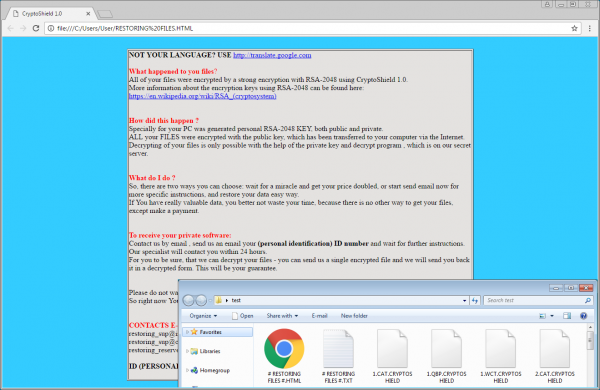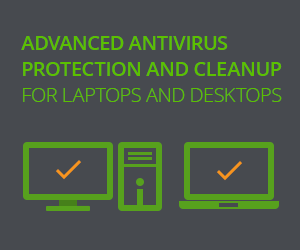CryptoShield 1.0 Ransomware hops into your device right from the websites you browse through. That does not exclude other options, yet the said infection vector is the only one reported so far.

Websites distributing the extortion virus contains a malicious JavaScript. It is an EITest attack code. The code is so designed that it forces the browser to execute it. That injects a RIG exploit kit into computer memory. The infection dropped finally deploys the ransomware download and installation campaign. The kit cannot succeed in executing its payload unless there is a venerable piece of software on the hacked device. A vulnerable application is likely to be the one lacking timely updates. Captain Obvious says we shall keep our software timely updated.
The installed instance of CryptoShield 1.0 assigns an ID to the PC compromised. The ID is a unique identifier, to be reported by the victim to the crooks.
The infection is one of the variants representing notorious CryptoMix ransomware. This family of malware requires its victims to contact them by email. The initial instructions are available in txt and HTML files. A victim would find both items in any folder that contains the files encrypted by CryptoShield 1.0 extortion Trojan. Besides, to ensure the ransom note actually addresses the target audience, the ransomware generates a fake Windows alert. This alert pretends to originate from explorer.exe. Attentive reader would detect the fraud as the alert speaks broken English. A native Windows message undergoes so many stages of verifications that spelling ‘memory’ as ‘momory’ is hardly a possibility.
Once you click OK on that alert, a true Windows notification would inquire whether you allow smartscreen.exe to execute. If you do, the ransomware displays its ransom note. The notification indicates your unique ID that you are supposed to report in the email to be sent to the attacker.
The attacker’s feedback typically arrives within 24 hours. It would demand 5 Bitcoins to be transferred to the wallet indicated. Otherwise, according to the reply, the data remains encrypted.
The scrambling applied by CryptoShield 1.0 is AES-256. It is a really strong algorithm, withstands any brute force attacks. To make things worse, the trojan also badly modifies file names. For that purposes, it applies a stand-alone cryptosystem, ROT-13. Also, .CRYPTOSHIELD extension is added, hence the name of the ransomware.
Beware the amount of 5 bitcoins is currently approaching 5,000 USD. The sum is huge, yet does not ensure the key is duly released. Try the free recovery workarounds as available below to get rid of CryptoShield 1.0 malicious encryption. These do not ensure the data becomes fully restored, but often satisfy the users concerned.
Automatic removal of CryptoShield ransomware
The benefits of using the automatic security suite to get rid of this infection are obvious: it scans the entire system and detects all potential fragments of the virus, so you are a few mouse clicks away from a complete fix.
- Download and install recommended malware security suite
- Select Start Computer Scan feature and wait until the utility comes up with the scan report. Proceed by clicking on the Fix Threats button, which will trigger a thorough removal process to address all the malware issues compromising your computer and your privacy.
Restore files locked by CryptoShield ransomware
CryptoShield represents a unique category of malicious software whose attack surface reaches beyond the operating system and its components, which is why removing the virus itself is a part of the fix only. As it has been mentioned, it encrypts one’s personal information, so the next phase of the overall remediation presupposes reinstating the files that will otherwise remain inaccessible.
-
Launch data recovery software
Similarly to the rest of its fellow-infections, CryptoShield most likely follows an operational algorithm where it erases the original versions of the victim’s files and actually encrypts their copies. This peculiarity might make your day, because forensics-focused applications like Data Recovery Pro are capable of restoring the information that has been removed. As the virus further evolves, its modus operandi may be altered – in the meanwhile, go ahead and try this.
-
Take advantage of Volume Shadow Copy Service
This technique is based on using the native backup functionality that’s shipped with Windows operating system. Also referred to as Volume Snapshot Service (VSS), this feature makes regular backups of the user’s files and keeps their most recent versions as long as System Restore is on. CryptoShield virus hasn’t been found to affect these copies therefore the restoration vector in question is strongly recommended. The two sub-sections below highlight the automatic and manual workflow.
- a) Use Shadow Explorer
Shadow Explorer is an applet that provides an easy way of retrieving previous versions of files and folders. Its pro’s include an intuitive interface where the computer’s entire file hierarchy is displayed within one window. Just pick the hard disk volume, select the object or directory to be restored, right-click on it and choose Export. Follow the app’s prompts to get the job done.

- b) Use file properties
Essentially, what the above-mentioned Shadow Explorer tool does is it automates the process that can otherwise be performed manually via the Properties dialog for individual files. This particular approach is more cumbrous but just as effective as its software-based counterpart, so you can proceed by right-clicking on a specific file, which has been encrypted by CryptoShield ransomware, and selecting Properties in the context menu. The tab named Previous Versions is the next thing to click – it displays available versions of the file by date of the snapshot creation. Pick the latest copy and complete the retrieval by following the prompts.

-
Data backups work wonders
Ransomware like CryptoShield isn’t nearly as almighty and destructive in case you run regular file backups to the cloud or external data media. The virus itself can be completely removed in a matter of minutes, and the distorted information can then be just as easily recovered from the backup. Luckily, this is a growing trend, so ransom Trojans are hopefully going to become less subversive in the near future.
Verify thoroughness of the removal
Having carried out the instructions above, add a finishing touch to the security procedure by running an additional computer scan to check for residual malware activity
